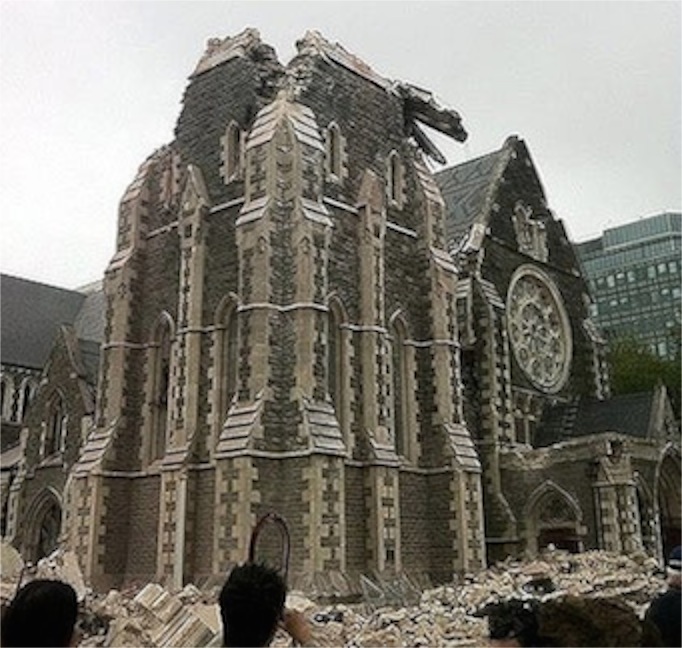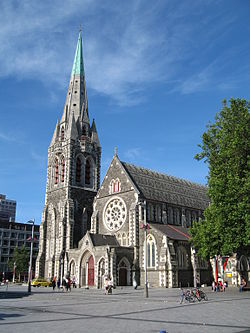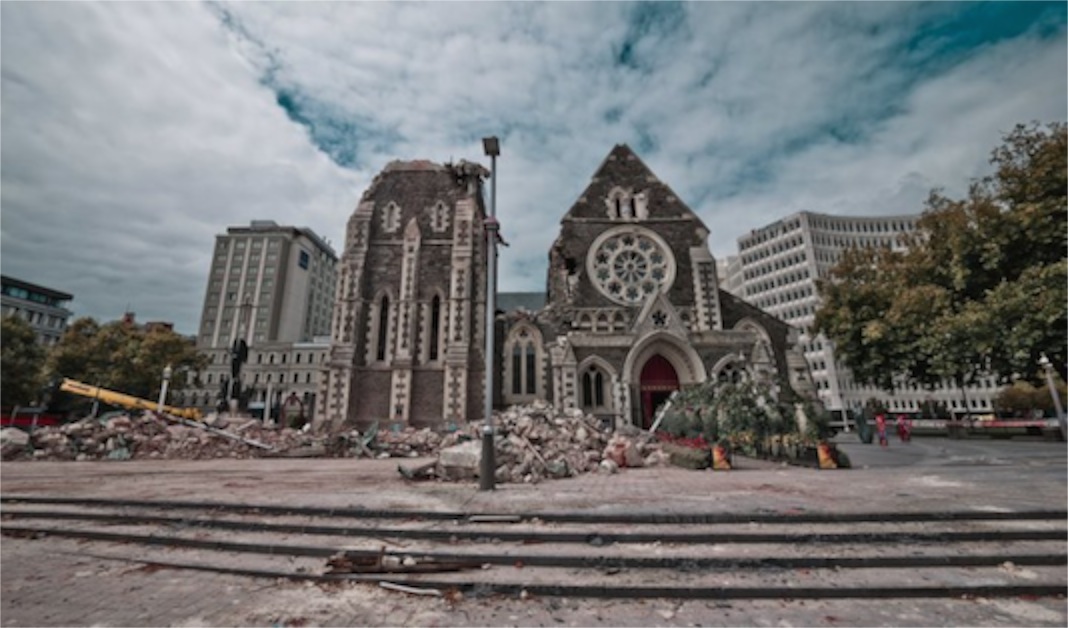Rebuilding a Cathedral
02/03/12 04:43
I have never been to New Zealand. So any comments I have to make about Christchurch Cathedral are made from afar. If I had gone to New Zealand, however, you can be sure that the cathedral would have been on my list of places to visit. I have visited churches and cathedrals all over the world. I am well aware that there are sacred places that are not the product of human construction, but there are some human constructions that are so impressive that they point beyond the people who built them. I have no doubt that the cathedral was one of those places.
But the decision came down yesterday (or today, I can never get the days right when peering across the International Time Line): The Cathedral will be taken down and replaced by a new structure. The venerable old church has simply suffered too much structural damage from earthquakes to make reconstruction practical.
 It has seen a few earthquakes. Within a month of the cathedral’s consecration in 1861, a quake dislodged a stone from the finial cap, just below the cross. Seven years later the 1888 North Canterbury earthquake caused a large section of the spire to fall. The spire was replaced. Earthquakes caused additional damage in 1901, 1922 and 2010. The February 2011 earthquake was 6.3 in magnitude and left the cathedral damaged and surrounding buildings in ruins. The spire was completely destroyed. Part of the roof collapsed. Further significant damage occurred in quakes in June and December of 2011.
It has seen a few earthquakes. Within a month of the cathedral’s consecration in 1861, a quake dislodged a stone from the finial cap, just below the cross. Seven years later the 1888 North Canterbury earthquake caused a large section of the spire to fall. The spire was replaced. Earthquakes caused additional damage in 1901, 1922 and 2010. The February 2011 earthquake was 6.3 in magnitude and left the cathedral damaged and surrounding buildings in ruins. The spire was completely destroyed. Part of the roof collapsed. Further significant damage occurred in quakes in June and December of 2011.
The only way to repair the building is to tear down, or deconstruct most of the damaged structure. An emotional battle is being waged over whether the replacement should be a replica or have a new look. Anglican Bishop Victoria Matthews said a new cathedral with a different design would be built in its place. She did announce that no bulldozers or wrecking balls would be employed as the cathedral is deconstructed “with the utmost care and respect.”
 It is not easy to build a cathedral. It took Bishop Henry John Chitty Harper two years to get the diocese to approve the construction of a cathedral. It was another six years before the cornerstone was laid. From the beginning there were problems with escalating costs and shortfalls in fund raising. The construction proved to be more difficult than anticipated. For eight years between 1867 and 1873 little work was accomplished. The novelist Anthony Trollope declared that the cathedral was a huge failure built on “vain foundations” when he visited in 1872. It took until 1881, a quarter of a century after the cathedral project was envisioned, before the nave and tower were consecrated. Another 15 years of construction were required after that before the transepts, chancel and sanctuary were finished.
It is not easy to build a cathedral. It took Bishop Henry John Chitty Harper two years to get the diocese to approve the construction of a cathedral. It was another six years before the cornerstone was laid. From the beginning there were problems with escalating costs and shortfalls in fund raising. The construction proved to be more difficult than anticipated. For eight years between 1867 and 1873 little work was accomplished. The novelist Anthony Trollope declared that the cathedral was a huge failure built on “vain foundations” when he visited in 1872. It took until 1881, a quarter of a century after the cathedral project was envisioned, before the nave and tower were consecrated. Another 15 years of construction were required after that before the transepts, chancel and sanctuary were finished.
No one knows how long it will take to build a new cathedral. No one yet knows what the new structure will look like. What is known is that the existing building is unsafe. It cannot be used for worship or for other work of the church. There are hundreds of heritage items that need to be salvaged in the process of deconstruction. Many stained glass windows are still intact. Memorial stones that were built into the cathedral need to be salvaged. Even if the building is taken down, the commitment of the church to preserving memory will not be lost.
News reports from New Zealand tell of a public debate over the structure. Conservationists are asking the church to reconsider the decision to deconstruct the building. They want officials to look at other options for reinforcing and keeping the existing structure. It seems as if everyone has an opinion.
It shouldn’t be surprising that the building engenders strong emotions. I serve a congregation that is relatively small compared to those who worshiped in the cathedral. Our building is just over 50 years old. But I know how strongly people feel about the building. One afternoon I spent over an hour listening to a member of our community who is not a member of our congregation as he talked about his reverence for the architect who designed our building and how important details in the building were. This man made it clear that he would be upset if we were to change the color of the paint on the steel beams that support the sanctuary roof.
Communities develop a sense of ownership for buildings. And sometimes the ones who haven’t belonged or even participated express the deepest sense of shock when decisions are made. The bishop and diocese of the Christchurch cathedral will be criticized whatever decisions they make.

It seems to me that Lent is the appropriate season to consider the future of the cathedral. With a smudge of ashes on our foreheads we all begin this season with a simple declaration that we do not go on forever. We are all mortal. “From dust you have come, to dust you will return.” Worshipers in Christchurch gathered in a park. Mixed in with the ashes of last year’s palms was a bit of dust from the collapse of the cathedral. With tears and solemn prayers they remembered the 185 people who died in the earthquake and aftershocks. The tremor had changed everything for the people. The memory is fresh.
Like our very lives, the works of human hands are temporary. We gain an illusion that we can make things that will last a long time by virtue of the simple fact that there are plenty of buildings that have outlasted a single generation. Previous generations have constructed buildings that have lasted centuries and, in some rare cases, millennia. It gives us an illusion of permanence. From the perspective of the eternal, human efforts all come to an end. “From dust we have come, to dust we will return.”
As I said at the beginning of this reflection, the people of New Zealand shouldn’t be influenced by my opinion. The decisions about what to do next with the cathedral are not and should not be mine. But for what it is worth, I think the time has come for them to do something new. Even if it takes decades, I believe that a new cathedral in Christchurch is worthy of the sacrifice and work. Perhaps the new building could incorporate the latest in earthquake resistance. Perhaps it could be energy efficient and low maintenance.
Most of all, I hope that it does not attract too much attention to itself. Every church and every cathedral should point beyond itself. It is not now and it never has been about the building. It is always about the relationship with God.
May God bless the people of Christchurch as they seek direction for the future of their cathedral.
But the decision came down yesterday (or today, I can never get the days right when peering across the International Time Line): The Cathedral will be taken down and replaced by a new structure. The venerable old church has simply suffered too much structural damage from earthquakes to make reconstruction practical.

The only way to repair the building is to tear down, or deconstruct most of the damaged structure. An emotional battle is being waged over whether the replacement should be a replica or have a new look. Anglican Bishop Victoria Matthews said a new cathedral with a different design would be built in its place. She did announce that no bulldozers or wrecking balls would be employed as the cathedral is deconstructed “with the utmost care and respect.”

No one knows how long it will take to build a new cathedral. No one yet knows what the new structure will look like. What is known is that the existing building is unsafe. It cannot be used for worship or for other work of the church. There are hundreds of heritage items that need to be salvaged in the process of deconstruction. Many stained glass windows are still intact. Memorial stones that were built into the cathedral need to be salvaged. Even if the building is taken down, the commitment of the church to preserving memory will not be lost.
News reports from New Zealand tell of a public debate over the structure. Conservationists are asking the church to reconsider the decision to deconstruct the building. They want officials to look at other options for reinforcing and keeping the existing structure. It seems as if everyone has an opinion.
It shouldn’t be surprising that the building engenders strong emotions. I serve a congregation that is relatively small compared to those who worshiped in the cathedral. Our building is just over 50 years old. But I know how strongly people feel about the building. One afternoon I spent over an hour listening to a member of our community who is not a member of our congregation as he talked about his reverence for the architect who designed our building and how important details in the building were. This man made it clear that he would be upset if we were to change the color of the paint on the steel beams that support the sanctuary roof.
Communities develop a sense of ownership for buildings. And sometimes the ones who haven’t belonged or even participated express the deepest sense of shock when decisions are made. The bishop and diocese of the Christchurch cathedral will be criticized whatever decisions they make.

It seems to me that Lent is the appropriate season to consider the future of the cathedral. With a smudge of ashes on our foreheads we all begin this season with a simple declaration that we do not go on forever. We are all mortal. “From dust you have come, to dust you will return.” Worshipers in Christchurch gathered in a park. Mixed in with the ashes of last year’s palms was a bit of dust from the collapse of the cathedral. With tears and solemn prayers they remembered the 185 people who died in the earthquake and aftershocks. The tremor had changed everything for the people. The memory is fresh.
Like our very lives, the works of human hands are temporary. We gain an illusion that we can make things that will last a long time by virtue of the simple fact that there are plenty of buildings that have outlasted a single generation. Previous generations have constructed buildings that have lasted centuries and, in some rare cases, millennia. It gives us an illusion of permanence. From the perspective of the eternal, human efforts all come to an end. “From dust we have come, to dust we will return.”
As I said at the beginning of this reflection, the people of New Zealand shouldn’t be influenced by my opinion. The decisions about what to do next with the cathedral are not and should not be mine. But for what it is worth, I think the time has come for them to do something new. Even if it takes decades, I believe that a new cathedral in Christchurch is worthy of the sacrifice and work. Perhaps the new building could incorporate the latest in earthquake resistance. Perhaps it could be energy efficient and low maintenance.
Most of all, I hope that it does not attract too much attention to itself. Every church and every cathedral should point beyond itself. It is not now and it never has been about the building. It is always about the relationship with God.
May God bless the people of Christchurch as they seek direction for the future of their cathedral.